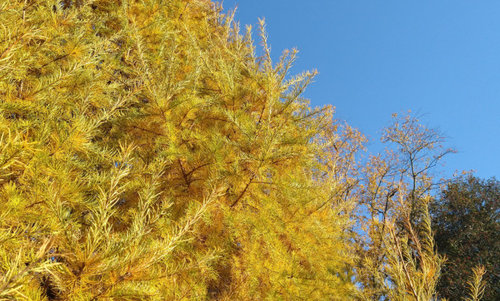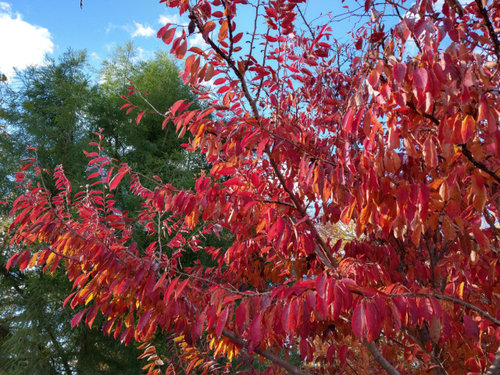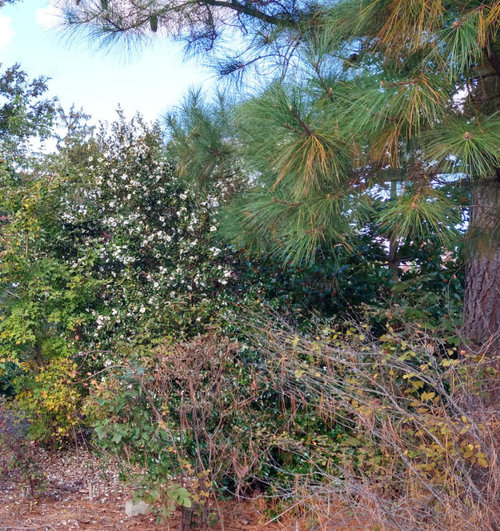Better Homes And Gardens Dinnerware Autumn Amber
Time for another one of these. For better or worse, I'm addicted to plant advocacy!
Let's start on the theme of autumn color. Here is the larger of my 2 larix kaempferi. Sorry for the crop but I can't easily get a picture of all of it without showing either my house or my neighbor's. It's a pretty generic 25' narrow cone. I just noticed this week that the autumn foliage has a delightful almost sweet odor.

In the very distance you can make out an American holly I disparage on this thread for having multiple trunks. I will eventually remove it...other BLE screening is growing in its place. But at least that holly fruits every year! I have another old Ilex opaca in this part of the garden that is a REAL dud, it only fruits every two or three years! An odd trait: it's not lack of pollen because all other female American hollies in the garden fruit regularly.
Worth noting the other of my larch is in a semi-shaded area and has a much more open, 'scarecrow' habit of a Cedrus deodara.

Here is the (nowadays) legendary Parrotia subaequalis. If I had to name a 'desert island' tree for fall color in my region, it would be this. It's reliable every year and it goes on an almost ridiculously long transformation over several weeks if not a month. I have some trees that can be stunning some years - like my Cornus urbiana X Cornus florida that I'm trying to get a nursery to introduce - and blah the next. This is always incredible.
Whomever developed my property years ago planted whatever cultivars of Japanese maple were mainstream in the 1950s...the consistency between at least two of them makes me pretty sure they were grafts. I have cultivars I planted when I moved here 15 years ago, and other people on my street have more recently planted ones, so there's genetic diversity. I have selected a couple of seedlings that seemed to have something different about them, like this one that appears to have exceptionally diaphanous leaves.

Behind it is a wonderful fall blooming Camellia called 'Scented Snow'.

But whether this trait is really unique? I don't know. I do have a keen eye and it's definitely noticeable in my garden vs. the other Japanese maples, but I'd have to 1) visit a large collection of well maintained cultivars or 2) have an expert vouch for it really being special. I think the world already has enough cultivars and new ones should only be introduced if they are truly distinctive.
I fully admit to photographing my plants in the most flattering angle possible. I'm including this photo of the "ugly" side of one of my large Camellias though. I love my 'puffy pine' which I'm almost sure is a Pinus taeda X P. palustris hybrid of some sort - maybe only 25% or 12.5% longleaf pine. The needles average about 9 inches. But what I'm drawing attention to is how the released fascicles get caught in everything!

(you could be surprised to see me letting an ugly red maple seedling grow so large. But this is what I consider an 'advanced gardening technique'. To temporarily let a weed tree grow. I'm letting it grow for a few years to shade a rare rhododendron, while something better fills in. This whole area used to be shaded by a gigantic hemlock)
Now onto some more flowers. Here is an aconitum with the dried flower heads of Hydrangea macrophylla 'Nigra'.

I didn't plan this, it's just one of those happy coincidences that emerges and always makes gardening interesting and full of surprises.
I'm just close enough to the waters of the upper Ches. Bay to get a slight protective effect in fall. Since I moved here, the average for a hard freeze has been around Thanksgiving; where I gardened before in the western 'burbs of DC it was definitely more like mid-late October. We have had a light freeze, but still in sheltered areas or near the house, various flowers are chugging along. Take this Ginger 'Pink V' for example - I just took this pic yesterday. It seems more pink in the summer and more peach in the fall.

In the background of the pic of the Parrotia above, u see the dense needles of Taxodium X 'Banita', formerly 'T502'. This provides overstory protection. Another ginger in a more exposed area was trashed.
I admit I have struggled to establish gingers, but on this south slope under a deciduous conifer area, this soil seems to stay warm and dry enough in winter. Still I am fully aware a cold enough winter could wipe this out, and it's on my list of plants to always keep backups of in my 'conservatory' aka garage with HID lamp LOL.
Brent & Becky's recently started offering some newly hybridized Amarine bulbs. The Dutch woman who crossed these is a professional horticulturalist...I've seen her instagram but her name escapes me at the moment. Here is A. 'Belladiva' with a Salvia that survived the light freeze because they were right next to the house.

(bonus points to anybody who IDs the 3rd plant in this pic!)
Having now grown both parents, I can assuredly say these plants show hybrid vigor. But they are also something to acknowledge could be hit by a bad winter. I had a huge colony of Nerine bowdenii that survived both PV winters, only to die out in "PV 3" because 1) PV 3 didn't have snow cover and 2) I had just divided the clump that summer, so they weren't very established. I'm pretty sure those have 'contractile roots' that pull the bulbs deeper...cuz they were lower than I remember planting them...but they hadn't gotten low enough for 5" of frozen soil!
Speaking of growing both parents, some of you will remember my tale of ordering 6 large seed grown Amaryllis belladonna from the late, great, "Bill the Bulb Baron" of coastal California. I had seen some heart-stopping* displays of these during my September visit to the Italian Lakes region in 2010. I had to take an aggressive approach to establishing them in my garden ;-). I planted them in sheltered spots throughout the garden. Only 1 survived the ordeals of PV 1,2 & 3...which is always nice when you are deliberately trying to select for hardiness ;-). This year it bloomed so early I was able to try to cross it with some other Amaryllidaceae. Fingers crossed.

For the last of my allocated 10 pics in a new post, here is another one of the new hybrid Amarine, 'Tomoko'.

Thanks for taking this virtual tour with me!
* - and nose tingling. My 'Survivor' Amaryllis belladonna has, of course, an absolutely incredible fragrance. It must be in the world's top 10 floral fragrances. Alas, none of its offspring do. I also have Amarcrinums in the garden, which seem to take a long time to settle and bloom well. The Amarines, OTOH, bloom their heads off in the first year planted.
Better Homes And Gardens Dinnerware Autumn Amber
Source: https://www.houzz.com/discussions/6199280/scenes-around-the-garden-autumn-2021
Posted by: mccabethiss1969.blogspot.com

0 Response to "Better Homes And Gardens Dinnerware Autumn Amber"
Post a Comment